Index of chords
- How to construct all 7 chord variants in relation to the myxolidian scale
- G7 three digit
- Gmaj7 three digit
- Gm7 three digit
- Gdim
- G69
- G9
- Gm6
- Gm7b5 special
- G11
- G13
- Daug
- G7#9 and G7b9
- G7#9#5
- Scales, licks and phrases
- The Hungarian scale and its use in Minor Swing
- How to improvise over a fairly complex chord sequence for example All The Things You Are
- Question? Contact me!
Nassty chords and phrases simplified
using 3 finger settings where possible
When I resumed playing jazz guitar ( 40 years ago i played double bass, electric Precision bass in rock, blues, jazz whatever) I was confronted with some issues that I had forgotten or never learned back in the sixties.
Just for the heck of it here one very old take from around 1965, recorded with a very primitive recorder.
All the instruments you hear would be worth a substantial fortune now, Gibson SG, Precision Bass 1958, a Farfisa organ , Ampeq tube amps, and for the bass a 100W Vox top with two 15" Goodman speakers etc. It was called Good Friend ,regretfully i lost the text, and its inaudible; the tapes have degraded to dust.
As with most musicians of that era they lost or sold their kit at some stage, not realising the gold they had in their hands.
My jazz issues were gradually resolved as I learned the trick of simplifying from a professional jazz tutor.
If you try to comp a jazz classic (most bars have at least two chord changes) like for example Lullaby of Birdland or All The Things, at high velocity, you get your left hand in an untidy knot.
Check the 'Realbook' for all these oldies which are still very relevant and at the very least teach you to think about chords.
Most chords though can be reduced to a 3-finger setting which makes life suddenly much easier. If you play in a combo, the 3-string sound is more than enough as the keys and the bass (and others) will very likely play the missing notes.
I thought to share some examples of lessons I learned on this page, maybe useful and not only in jazz comping. Many contemporary songs even perhaps punk and metal deploy these strange chords.
Learn each chord in at least two positions in the beginning in order to avoid confusion. Frequently this will mean one with the root on the 6th string; in the lower regions of the neck, and the same chord with the root on the 5th string in higher regions of the neck (or higher and lower reversed).
Why two positions? Well it enables you to pick chords that are conveniently close to each other for a particular sequence or because you need to avoid the frequency range of lets say the keyboard.
For example if you play an Fmin7 followed by Bflat7, they are very close together in position 8, whereas you can play them as well in pos 1 close together. However playing the Fchord in pos. 1 and the Bflat in position 6 is not really handy. Thats why.
Obviously there are more variations but - especially when you start - these can be confusing. I will deal with the X7, Xmaj7, Xmin7, X9, Xmin9, Xdim and a few variants with flat5, sharp5, sharp9, flat9 etcetera.
All chords on this page are presented in a scale of G (except Minor Swing). The principles remain the same, so its easy transpose to another scale.
BUT FIRST - AN INTERESTING HARMONICS FRET 5 NON-ISSUE
When you try to play the harmonic (flageolet) at the fifth fret with only the neck pup active you will find it completely dead or almost inaudible.
Many players consider the tuning with the harmonics on fret 5 and 7 the most accurate way to do this., but using the neckpup only thats a no go.. I had a workshop participant in panic over his brand new Tele.
Thats not a problem with your guitar or the neck, its generic.
The point is that the neck pup sits roughly at the position of fret 24 which is a node with this harmonic. Look up what node is on Google.
At a node the amplitude of the string is almost zero, so for a pup nog enough to generate a signal.
Simply select another pup.
HOW TO CONSTRUCT THE 7, 9, 11, 13 CHORDS - MYXOLIDIAN
Here is an interesting overview how all the 7 chords in the G-family relate to each other. This will clarify things like G11, G13 and so on. Its by far not as complex as many people think.
This is not based on the scale of G major, but rather on the 7th scale, also called the dominant scale or Myxolidian (see further down on this page as well).
You know of course that the basic chord (here G) is made of i, iii and v or following the schematic below 1, 3 and 5, or g, b and d. Therefore you see that these notes in the second octave are also numbered 1 , 3 and 5 as they dont contribute a different sound. In the standard G major scale the F here would be a F# (as used in Gmaj7 !!).
Also important if you want to convert this to another tone is to remember that the formula for the distances between the notes in this scale are:
1,1,1/2,1,1,1/2, 1, so for Amajor this myxolidian would look like a,b,c#,d,e,f#,g and a. Easy.
The numbering of the dominant 7 chords family is based on two octaves of the myxolidian scale, with the notes numbered from 1 to 14 taking into account the notes above, see the table here:
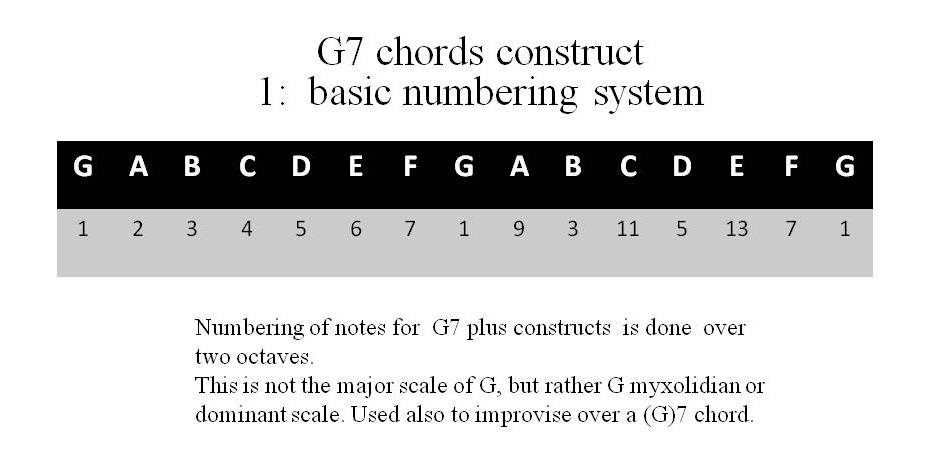
The following picture shows how to construct each following G7 variant based on the table. Easy!
You will see that i gave the second 3 a secondary number 10, although thats rarely used. I was confused some time ago by a keyboard player who told me to get G7b10 chord - never heard of that. What he meant of course was a G7#9, same thing and these tables make that a bit more comprehensible.
In altered chords you will encounter almost any of the additional notes flattened or sharp, mostly the 5, 9, 11, 13.
Another matter is how these chords look on a guitar fretboard. The guy on the keyboard has an easier life, with two hands you can easily grab all these and more! On the guitar you have to fiddle around a bit in order to play for example a G13 esxpecially with # or b - and that with only four fingers.
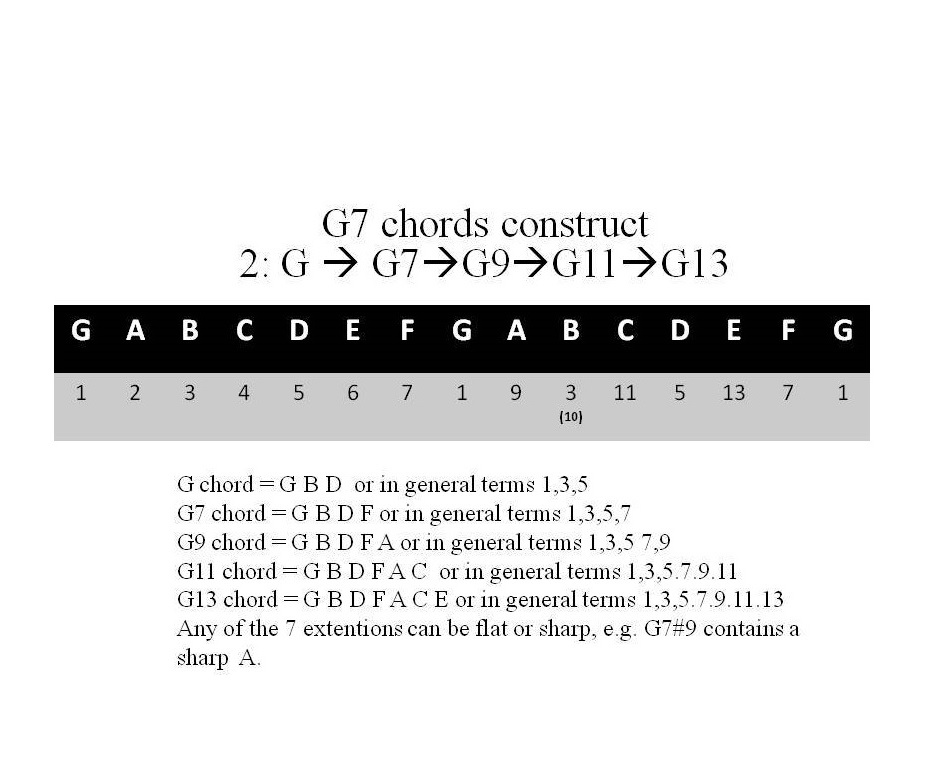
G7 - three finger variations in two positions
Forget the G plain (barree or open as in folk), rarely played in jazz, but everybody knows it and occasionally you can and will use it.
The G7 chord consists of : g - b - d - f or the general formula: i - iii - v - vii flat.
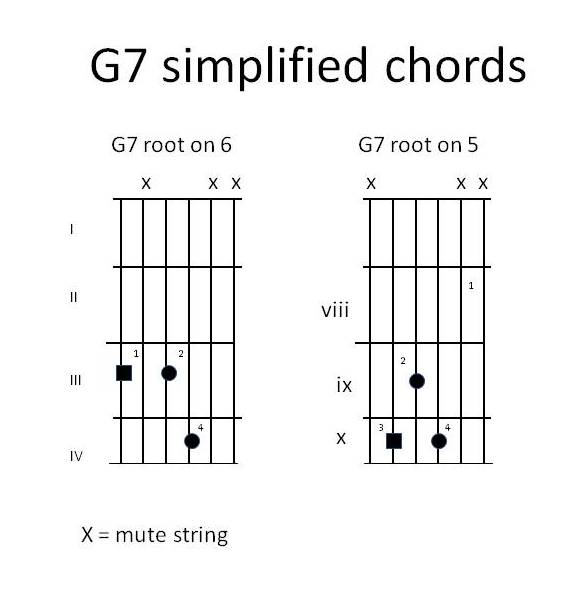
Here are the G7 subdominant chords in two positions (there are more but for starters this gives you a good and fast vocabulary).
These settings with 3 fingers only are very fast and sufficient when playing with others, which is the main purpose. For each of these sets I've made a short clip, so you can hear the sound.
Gmaj7 or GΔ chord in two positions
If you are used to the standard chords then this one needs some getting used to, but once your ear knows it its very nice chord which sounds great not only in jazz but in other music as well. The difference with the G7 chord is that the f is now played as an f-sharp, creating an almost dissonant tension against the root. The general formula then for this chord is These fingerings allow for very fast changes again, although there is one other I use frequently (i will add it later as it conflicts with the purpose of having only two variants for the time being). Again learn the root notes on strings 6 and 5 by heart, which give you the whole range for this chord.
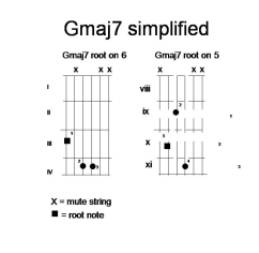
The notes in this chord are then g - b - d - fsharp or the general formula: i - iii - v - vii
There's a very interesting way to look at this chord, which is extremely useful when soloing over it. This chord is a combination of a plain G chord (g - b- d) and Bm (b - d - fsharp), use these notes to solo over a G chord and immediately it sounds ' jazzy'. Give it a try.
This sort of relation exists for all these modified chords. Note that the fsharp is the vii unmodified as per the scale of G, for example Cmaj7 would be c - e - g - b
Next to the drawing i have given an alternative fingering that sometimes is easier - try both.
Gmin7 - three variants (yes , sorry three)
This chord is frequently used, therefore three variants, basically the choice is determined by the next chord.
For example if you play Gmin7 in position X, followed by a C7 in position 8 then the middle variant sounds nice and is easy to play.
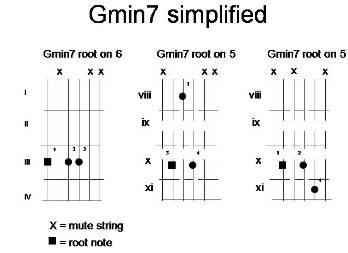
In practice we write Gm7 for minor, as opposed to maj for major. For shortness however, Gmajor7 is written as GΔ . In position III you would play the root with 2 and the remaining to with 3 (mini-barree). You can now try your speed on a sequence from Lullaby of Birdland, play fast, 140 or thereabouts: / Cm7 - Am7 / D7 - G7 / you can easily repeat this as the G7 leads back to the Cm7. Use Cm7 in pos. 3 with the root on 5, Am7 in pos. 5 with the root on string 6, D7 basically also on pos 5, with the root on string 5, G7 in pos. 3 with the root on string 6.
Gdim - diminished chords
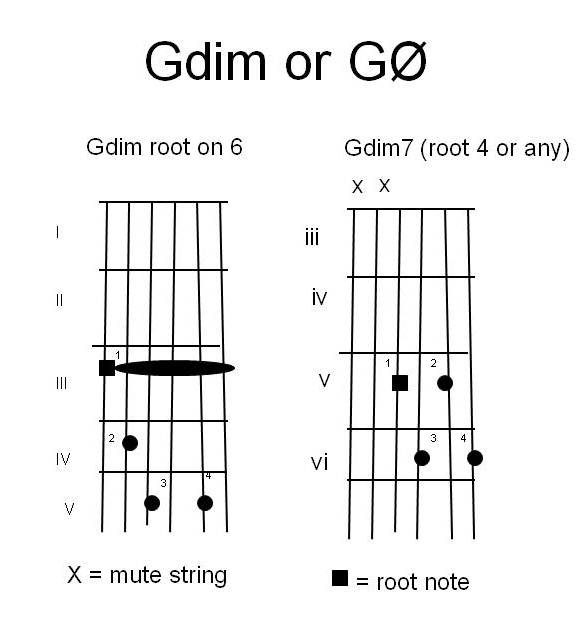
These chords are not exactly simple but are used very frequently.
They have an interesting property in that they can be used which each of the four notes as root denominator. Gdim and Gdim7 chords are considered different in some publications, however I was tought that they need not to be distinguished. Why? Needs some more research. Note there's an error in the neck positions for the dim7 chord. Will be corrected.
Another, shorter notation is GØ.
G69 - variants
If you take the G9 chord and flatten de 7 again, you get the tone e, or in fact the 6, leave the a (ix) and there is the 69 chord (no pun intended).
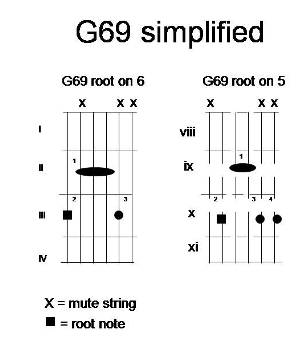
You can play G6 of course (later) but this one is used often again instead of the standard, unmodified G.
Play it with digit 1 as a small barre. The G69 chord consists of : g - b - d - e - a or the general formula: i - iii - v - vi - ix.
G9 - easy
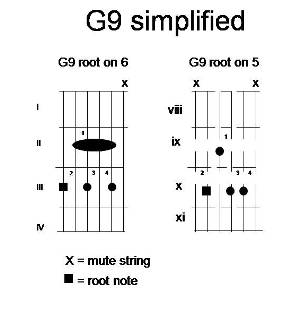
(ah well, easy? on the other hand I still have few fingerbreakers in store!)
A nine chord is standard (of course there are other variations, like add9 - later) the G7 subdominant with the nineth note - here the a - added. So the formula would be g - b - d - f - a or the general formula: i - iii - v - vii flat - ix Use: yn many cases you can use this as a more interesting variant of the G7. This one is probably one of the more difficult chords to play in this series - but as its used frequently you better get used to it. In the demo i play the G9 in pos III without the little finger (4), which makes it just a bit faster..
Here short clip on the G9:
Note that I use a simplified variation of the po III chord above. Leaving out the finger 4, its much easier to flip between the 7 and the 9 chords.
If some others (e.g. keyboard) play the root note, you might as well leave it out as it doesnt contribute anything to tthe harmony. The G9 becomes then a fast and simple three note chord again. Works for other chords as well.
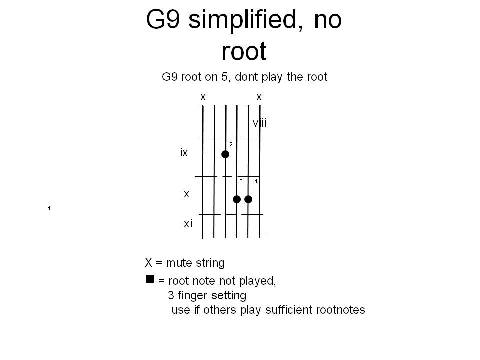
Gm6
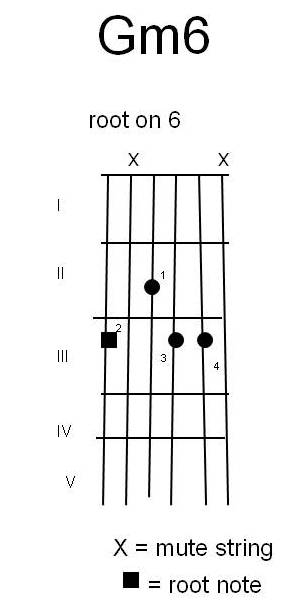
Only one variant here. There are others but in many cases this one will do as you can easily slide up and down the neck. I dont like the sound of other fingerings too much - even if they are correct. Its almost C9, but without the C-root.
Used in many Gypsy tunes - have a look at Django's 'Minor Swing', dont break your fingers when trying to Django it .
Gm7b5 aka G0 - useful chord with a nice moody sound
Used as a passing chord for example the sequence Gm7b5 / C7 / Fm basically a II/V/I sequence in a minor setting. The same sequence you will find e.g. in Autumn Leaves. Notation is often as G0 (zero), not to be confused with the dim chord notation, GØ..
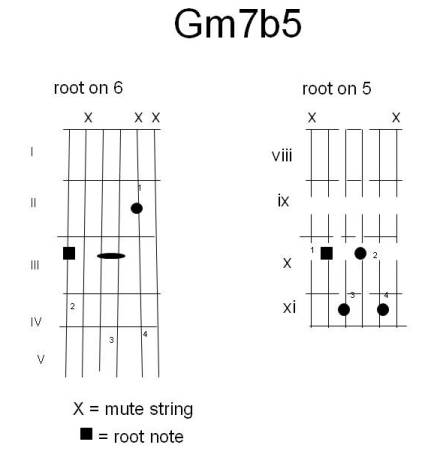
Following clip lets you hear the sound of this chord, shows a bit how its used in an oldie from the realbook called "Beatiful Love'.
Hope its useful
G11 - funky
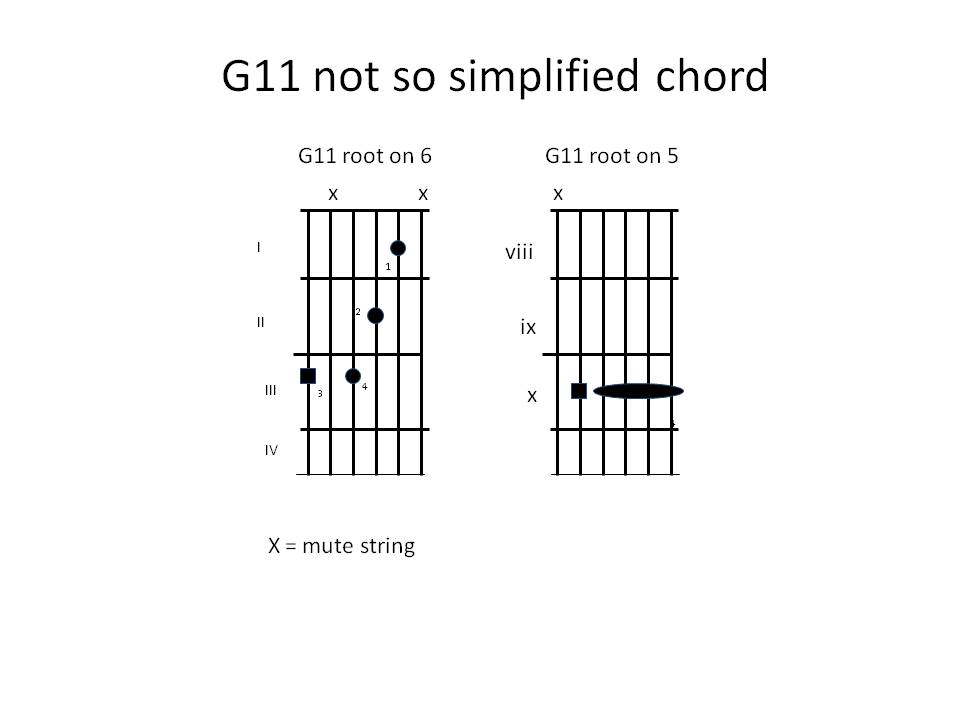
Especially the left version has a nice funky sound used many times but a good example is the song Streetlife
Use yur own prefrence how to do the small barre at the right. Sometimes, you can also see this as F/G (F chord with G in the bass)
G13 - jazzy
I prefer the version on the left side, easier to grab and i'm a lazy sod.
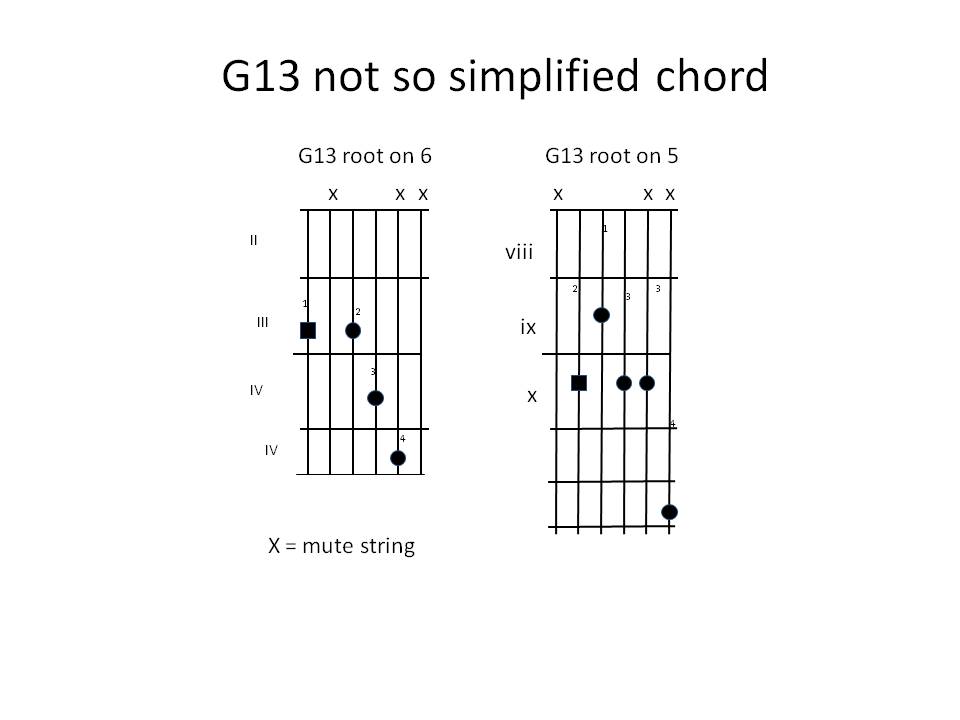
- adjust the saddle height such that there is no rattle in any position Basically this is a mix of a 7 chord plus a 6 (yes! makes 13!)..
Gmaj13 - jazzy
You can hear the chord in the G13 clip above.
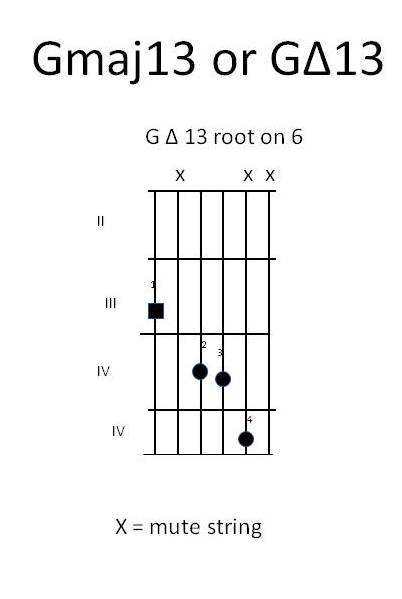
Daug - turnaround
I love this chord as a turnarounder like in the Allman Brothers "Stormy Monday", but you will find other uses where you want to create suspension before turning back to the root key - in this case G. Listen to the song on Youtube - great blues. Daug works as the 12th bar in any blues, before returning to the root. Don't overdo it. I am using it in the short demo on the blues scale so you can hear it there.
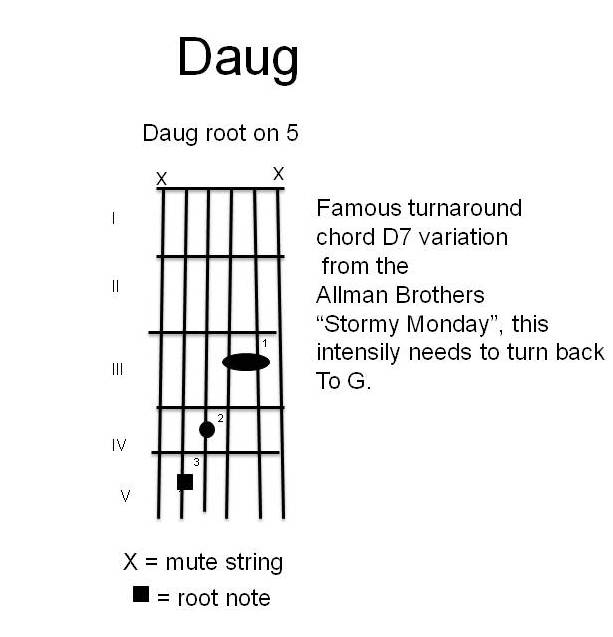
G7#9 and b9
The G9 is a great sounder, these two variations need some getting used to but give a subtle enhanced feel to the chord.You can figure out easily what these chords could look like in position III (root on 6) The notation is as a variation to the 7-chord (basically G9 also is an extension of the 7 chord).
Recommendation: if you are just beginning, let the keyboard play these sharp or flat nines, you only have to play the seven chord with three fingers. Keyboard has twice as many fingers to grab chords. Also if you are i doubt dont play the nine, if someone else plays the #nine it sounds ugly.
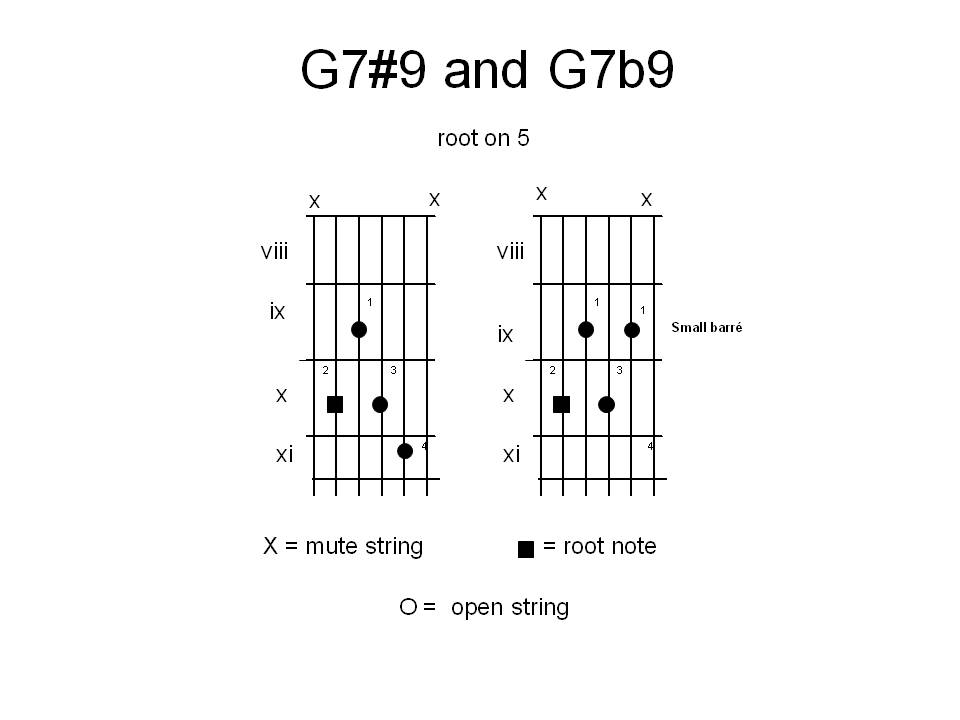
G7#9#5 and b9b5 - more mods of the G9 chord
Here two frequently used variations to the -9 chord. You can figure out easily what these chords could look like in position III (root on 6)
The notation is as a varation to the 7-chord (basically G9 also is an extension of the 7 chord).
The B7#9#5 chord is used by the great Jimi Hendrix. Try the chord and you'll hear why. Personally i dont like the b9b5 variation very much, although sometimes you just have to play it (remember the rule here: if others in the band play the sharp or flat nines and fives, you can just as well only play the G7.
Keep life easy.
Now figure out yourself all possible combinations of sharp 9,5 and flat 9, 5 (four combinations, four different chords)
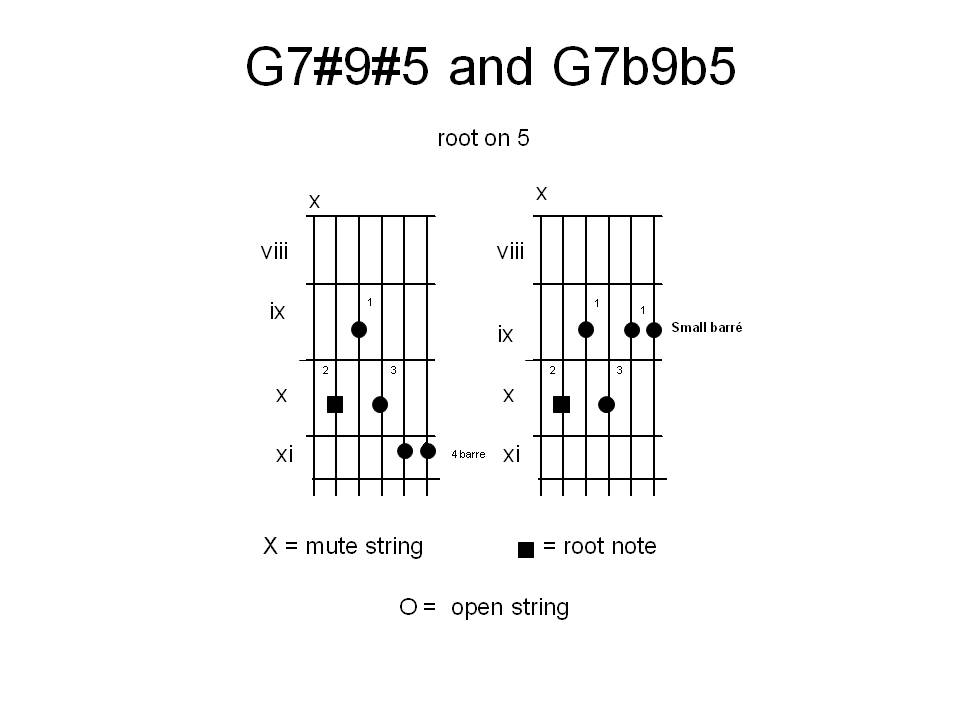
Soloing and a few useful licks or phrases
Some general guidelines when improvising in jazz
- avoid root notes for start and end
- keep solos simple (the art of leaving out stuff, rather than filling up everything with 64ths)
- watch your timing
- stick to tempi, dont speed up or slow down (perhaps the most difficult issue)
- get a copy of the Realbook so you can play everywhere wih anybody.
Simple soloing lick over II - V - I
Here are two fairly standard and very easy phrases that will help you soloing effectively over some frequently occurring chords ant chord sequences. They sound quite ooh and ah and are easily applied in different circumstances - so exercise them in all neck positions. II - V - I sequence
Remember this one. These are roman numerals and stand for 2, 5 and 1. This sequence happens all the time.
For example in in G, you would see Am7 - D7 - G, I (G) is the basic scale name, the II is obviously A(m) , and the V is D (count on your fingers to understand). This sequence is often used to come back from previous chords to the root scale (or change scale for that matter)
Here the last 8 bars from "All of me" - another Realbook oldie - in G, the relevant sequences are bold.
/ C/ C#dim/ Gmaj7 / E7 / Am7 / D7 / G /
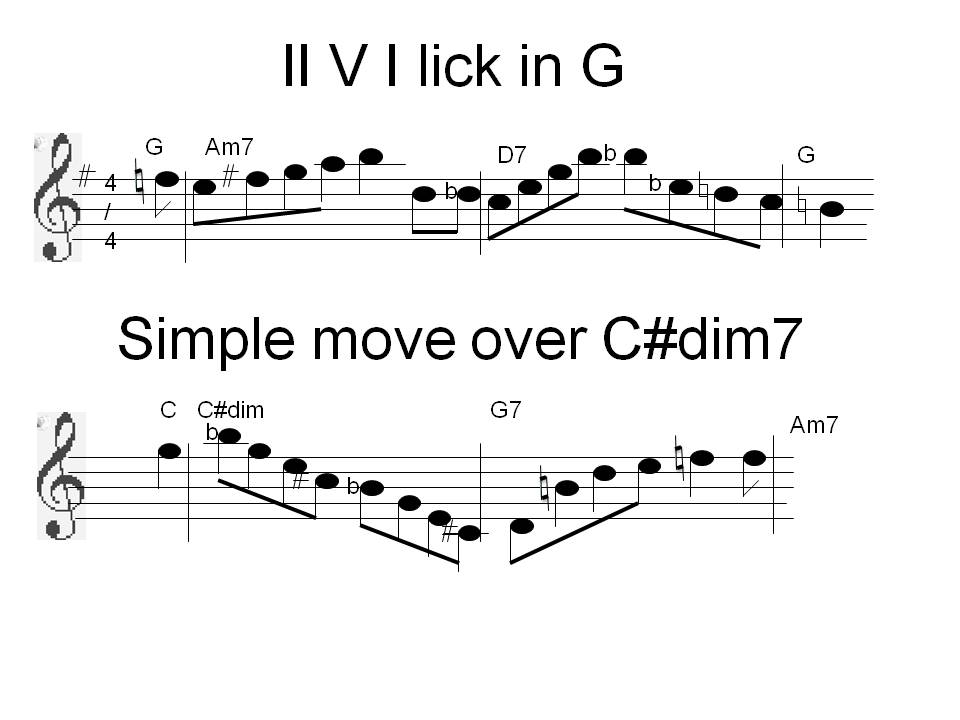
Phrase or lick to play over a dim chord
Very effective is this one (second phrase above) played over the (any) dim chord - in this case C#dim.
These notes are part of the diminshed scale.
It sounds quite good iwhen you play them downwards starting with pinky on posn VI (in the clip you can listen to the effect).
This dim scale can also be played over any standard 7 chord, sounds sophisticated.
Here is a clip (Youtube) showing both soloing suggestions. By the way, you know that you can name a dim chord after any tone in the chord? So the C#dim chord can also be named after and used as g0, e0, and bflat0 in addition to C#0. Useful little chord
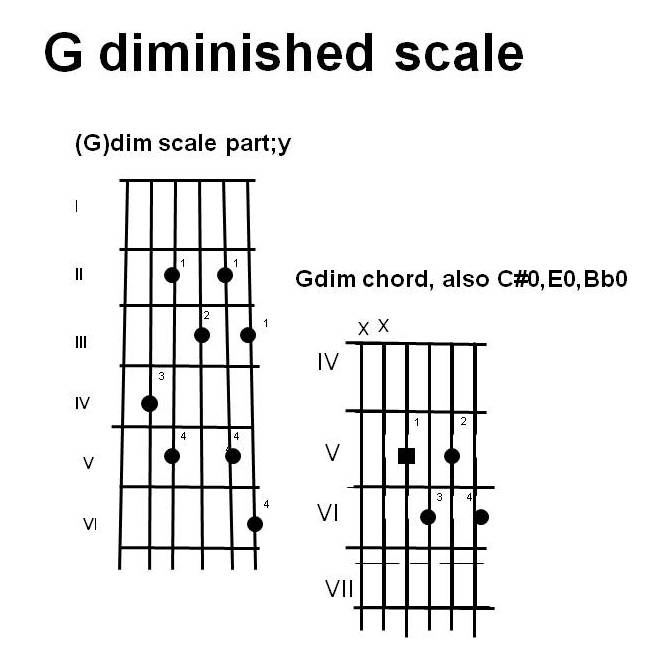
TRITONERS? WHAT THE F%$# IS THAT!
Take for example the 2/5/1 sequence Am7 - D7 - G, you can interestingly replace the D7 by a Ab7 (or G#7).
The sequence thus becomes Am7 - G#7 - G, which gives some nice opportunities for just that different solo.
The theory behind this is somewhat complex but it is simple to remember that you can replace the natural dominant sept by a chord which has some altered relations, but is one semitone above the scale you're playing in.
So in C, where you would find G7 you can play C#7 (play a Myxolidian scale - sounds difficult, but is just the normal major scale with the 7 flat, for this C# chord a B tone). In other words, tritone substitution involves replacing the dominant 7 chord's root, with one that is three whole steps away.
For example, D♭7 is the tritone substitution for G7 (count: G>A, A>B, B>C# or Db). Playing in C this turns out to be a semitone above the rootchord., easier to remember.
Look up the chords of Black Coffee, and see if you can recognize the tritoners there.
SCALES AND CHORDS OVER WHICH YOU CAN PLAY THEM
One of the mysteries when starting jazz improvisations is to answer the question "What bloody scale can I use over this particular chord or chord sequence".
If you are a bit more advanced it is possible to break down a piece into subsets of chordsequences over which you can play a particular scale - ask your teacher how to do this. Given time i may eventually do a write up on the subject.
Without going really into the deep here are a few possibilities that work
Hungarian Gypsy SCALE AS IN MINOR SWING
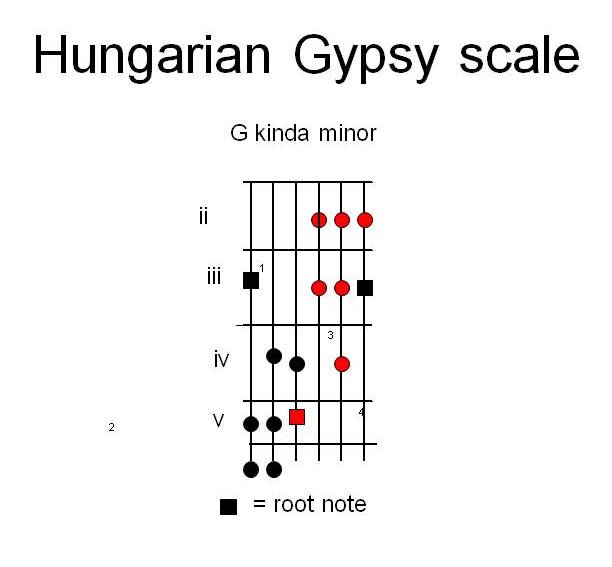
When I started fiddling with Django's Minor Swing, I found that improvising over these chords (Am6, Dm6, Bmb5 and E7 variants) was different from what i had done sofar.
Coming from jazz/blues your initial attempt is to use the minor scale, the pentatonic minor scale, or even the blues scale.
No go, sounds all wrong. A bit of research unveils that many people think that Django uses the Hungarian Gypsy scale, which is a minor scale of sorts with some funny variations. I've given here the Gm key variant as that is what all my other examples are, but move the root on E6 to position V and you have the Am family. Thats what i do in the clips.
I am not certain if Django really consciously did this.
There are other notes in his play which dont fit here. BUT, one thing is certain if you loosely use this scale for improv it will sound - almost - right. I think Django used notes from his cultural heritage, without bothering to give them a particular name or label as we like to do. So have a go. In particular the 7 against the flat 6 sounds well. in particular with a Amb5 in the G scale.
Below is another clip I made to show Minor Swing in Am in a speed that is attainable for mere mortals. It took me a lot of effort to puzzle it out from the Django clips - the fact that he plays it with only two fingers doesnt make it easier. It contains a slow speed backing track that you can use to exercise. Also try this gypsy scale!
Please note that i am not Django or Wes or Satriani, i just try to make a difficult piece of work accessible to beginners!
G MAJOR SCALE and GΔ chord
This is the standard major scale for G, starting with the root on string 6, third position.
You can easily work out the same scale with root on string 5, position 10. Exercise both for all important keys - you like that, huh? This scale works fine over the GΔ or Gmaj7 chord. Alternatively you can play an Em pentatonic over GΔ , the two keys are closely related. Have someone else play the GΔ chord and try, first the scale, then variations.
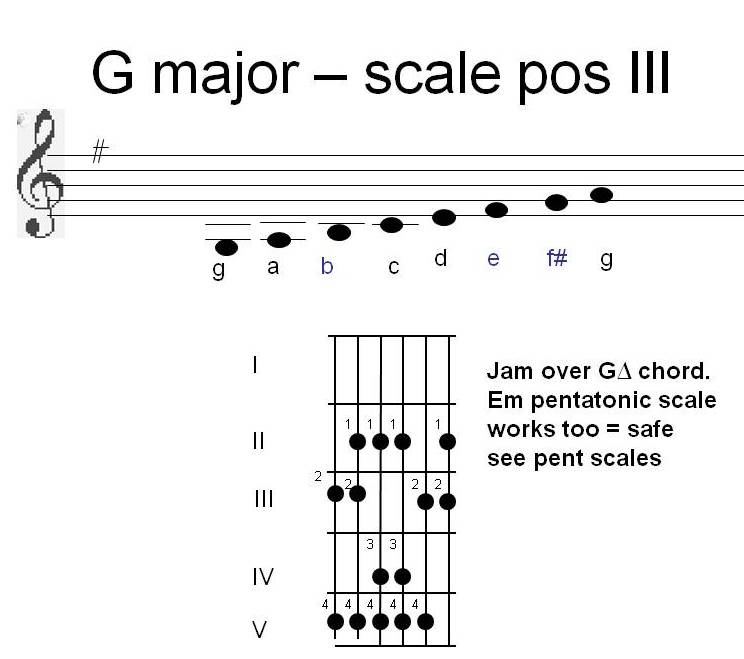
G7 scale over G7 chords - Myxolydian scale
this sounds frightening, yuk, myxolidian.
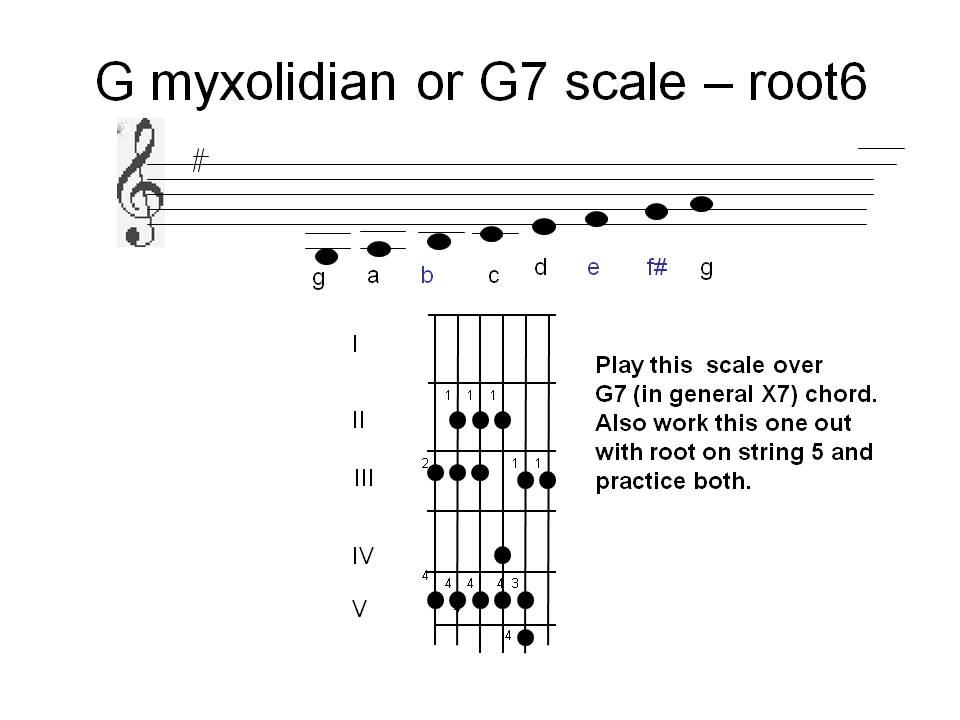
Don't give up, it's easier than you think!! Don't fret (sic!), its the same scale as above only with the 7th note flattened. Easy. Therefore you can use this over a G7 chord, otherwise the F# would conflict with the F.
To make life interesting this is also called the myxolidian scale. Again work this out with root on 5 and exercise a bit. A short clip demonstrating this follows:
G minor pentatonic scale, play over Gm or Gm7
Works wel over Gminor chords but also over Bb major.
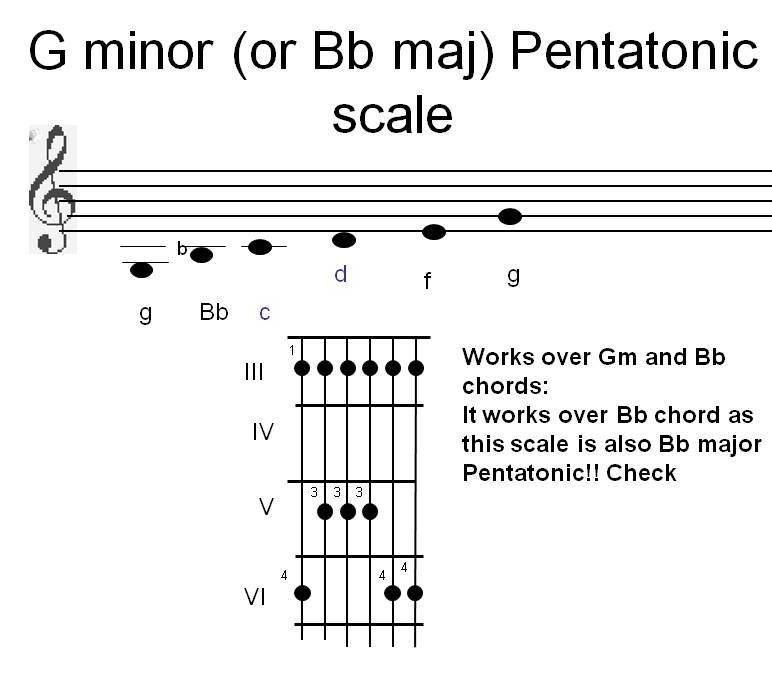
If you start the scale on the Bb tone you will see that suddenly it is also Bb major pentatonic, cool?
This means that you can find other sources of inspiration - try a Bb major pentatonic in position 6, with the root on 6, playing over Gm chords. You will make different solos.
See the difference with the blues scale below.
THE G BLUES SCALE, played over Gminor or Gmajor
The most used scale in guess - blues.
Take the minor pentatonic scale and add the 5flat, you get the blue note. See the red notes in scale map.
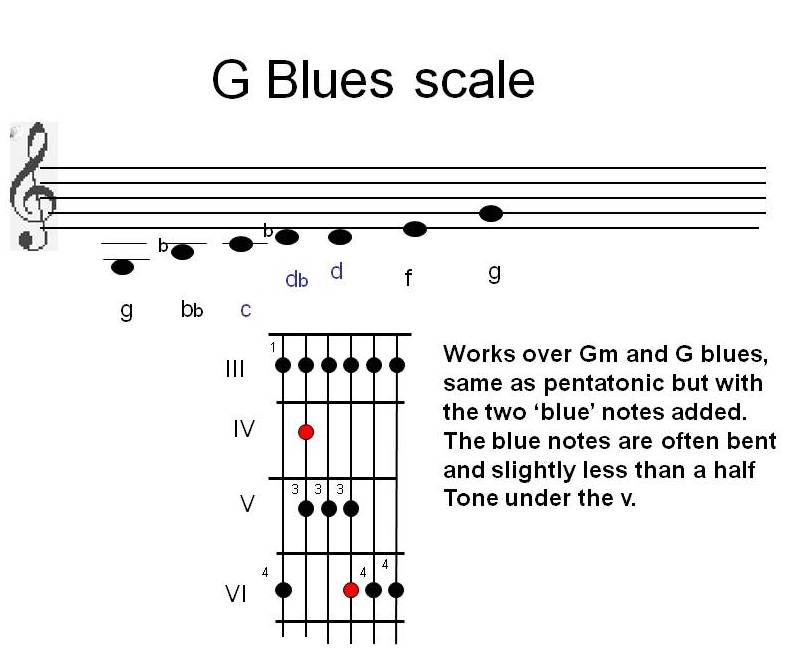
There are many theories what the source of the blue note is,; most likely it has to do with the African roots of the blues.
The blue note is more often than not a bent note, or bends towards the 5.
This scale is played over blues sequences in Gmajor as well as Gminor.

A nice example of a slightly embelllished or pimped blues sequence is above - I use that in the clip. Also note that at end of the 12bars I use the Daug as a return bridge instead of a straight D7, Daug creates a lot more tension.
Listen to Clapton's oldie Hideway in Emaj, but using the Eblues scale (which is a minor scale).
When you play this over Gmaj chords take care not to let conflict the flat iii (Bb) in the blues scale with the major B - you can use Bb as passing note, but avoid that as an resolution/end note.
Here a clip to demonstrate a way to start your blues career. Just play the scale straight over the chord sequence. You will find that the flat notes sound OK, even though the chords are major. From there start improvising, first by skipping notes - the rest follows!
Scales for improvisation over a complex jazz classic - All The Things You Are
When you are confronted with a chord sequence like this one as a beginner, you will be very confused how to go about building an improvisation.
The trick is to look for known sequences, like ii/v/i and also be on the lookout for tritoners.
I'll walk you through the lines:
The intro here as played by many musicians is not so important for improvisation. The issue here is the difficult timing (look it up on Youtube). Of interest is that the Ab7#9 is in fact a tritoner, replaces D7.
The main body of the song is neatly divided in 4-bar sequeneces, each with its own scale determined by ii/v/i sequences as follows:
Bar 1-4: this is clearly in Eb. Cm is the minor counterpart of Eb (same scale) and F/Bb/Eb is the ii/v/1. So use scale of Eb maj, or Cm for a different sound.
Bar 5-8: the Ab is a logical progression from the previous Eb, followed by a classic ii/v/1 leading to G. Here use the scale of G maj
Bar 9- 12: ssame story, but now it leads to Bb,, thus use that scale.
Bar 13-16: same, use scale of Dmaj
Bar 17-20: again ii/v/i but stays in Dmaj.
Bar 21-24: immediately moves via the C# as ii/v/i to B , so use that scale here.
Bar 25-28: same as bar 1-4, usse Eb
Bar 29-32: stays in Eb, then via the dim chord back to
Bar 33 - 35: ii/v/i back to Eb, with the Dm7b5 G7 used as a turnaround going back to bar 1, except for the last round where you stay in Eb
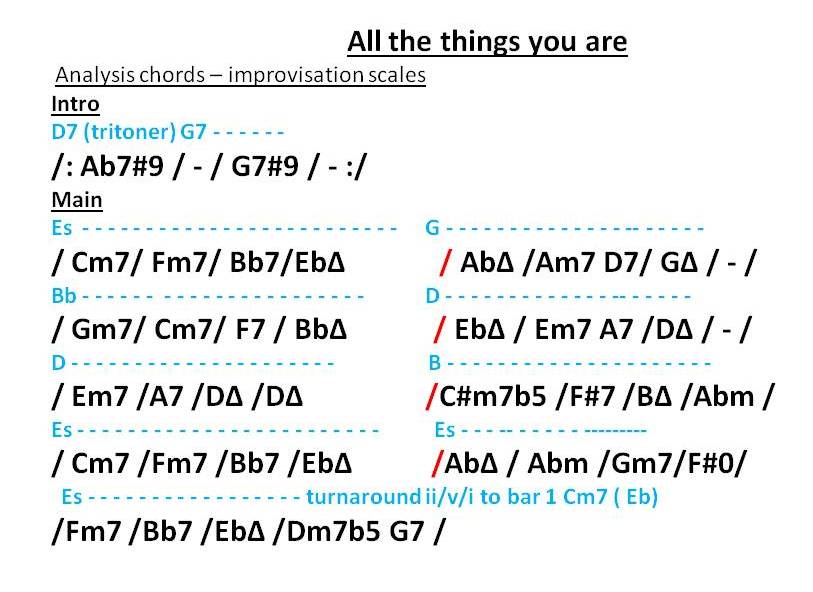
.
GUITARS RECYCLED - CONTACT
Use the link below to send me an email or go to the webshop:
